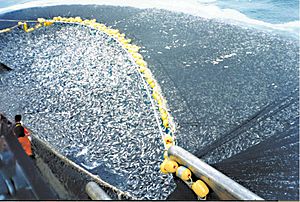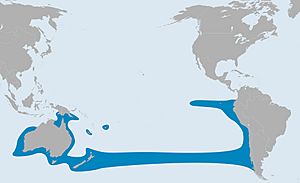Chilean jack mackerel facts for kids
Quick facts for kids Chilean jack mackerel |
|
|---|---|
 |
|
| A school of about 400 tons of Chilean jack mackerel encircled by a purse seine | |
| Conservation status | |
| Scientific classification | |
 |
|
| Estimated distribution | |
| Synonyms | |
|
The Chilean jack mackerel (Trachurus murphyi) is a type of jack mackerel. People sometimes call it the Inca scad or Peruvian jack mackerel. Since the 1970s, this fish has become one of the most important fish caught for food around the world. Many of these fish have been caught. However, there are worries that too many are being caught, which could harm their populations.
Contents
What Does the Chilean Jack Mackerel Look Like?
Chilean jack mackerels are usually about 45 centimeters (18 inches) long. Some can grow up to 70 centimeters (28 inches). They have long, flat bodies. Their heads are big, and their eyes have clear, protective covers. Their mouths are also large, with small teeth.
Each of their gill covers has a small notch on the back edge. They have two dorsal fins (on their back). The second one is much longer than the first. Their pectoral fins (on their sides) are long and pointed. The pelvic fins (on their belly) are located below the pectoral fins. The anal fin (on their underside) is long but shorter than the second dorsal fin. It has two strong spines at the front. The top part of their body is a shiny metallic blue, and their belly is silvery white.
Where Do Chilean Jack Mackerels Live?
The Chilean jack mackerel is a type of pelagic fish. This means it lives in the open ocean, not near the bottom. They swim in large schools near coasts and far out at sea. They usually swim between 10 and 70 meters (33 and 230 feet) deep. But they can go as deep as 300 meters (980 feet).
You can find them in the South Pacific Ocean. They live off the coasts of Chile and Peru, around New Zealand and southern Australia. They also live in a wide area across the open ocean between these places. This area is sometimes called the 'jack mackerel belt'. This belt stretches about 1,100 kilometers (680 miles) from north to south.
These fish usually spawn (lay eggs) in the summer. Their eggs float freely in the open sea. Scientists think there might be four different groups of Chilean jack mackerel. Some groups live near Chile or Peru, and others live in the open ocean or near New Zealand and Australia.
What Do Chilean Jack Mackerels Eat?
Chilean jack mackerels mostly eat tiny fish larvae (baby fish), shrimp, and other small crustaceans like copepods. They also eat squid and small fish. These fish can live for up to 16 years.
We don't know much about what animals eat Chilean jack mackerels. However, they have been found in the stomachs of albacore tuna and swordfish. Other types of mackerels are eaten by tunas, billfish, and sharks. So, it's likely these predators also hunt Chilean jack mackerels.
How Did the Chilean Jack Mackerel Get Its Name?
The Chilean jack mackerel was first described in 1920 by an American fish expert named John Treadwell Nichols. In 1996, some scientists thought it was a type of Pacific jack mackerel. But most experts now agree it's its own unique species.
The fish's scientific name, murphyi, honors an American bird expert named Robert Cushman Murphy. He collected the first sample of this fish near the Chincha Islands in Peru. Since 2004, the Chilean jack mackerel has been known as a "sister species" to the Pacific jack mackerel. This means they are very closely related.
Fishing for Chilean Jack Mackerel
Chilean jack mackerels are one of the most commonly caught fish that are not "true" mackerels. Fishermen catch them using large nets called purse seines or midwater trawls. They also use trolling (dragging lines with bait) or longlining (using very long lines with many hooks).
In the early 1970s, the number of Chilean jack mackerels grew a lot off the coast of South America. They became very important for fishing. The fish then spread west across the open ocean, reaching New Zealand and Australia. In 1997 and 1998, the amount of fish caught dropped sharply. This happened because of changes in ocean temperatures during an El Niño event. El Niño is a natural climate pattern that changes ocean currents and temperatures.
Chile has caught about 75% of the world's Chilean jack mackerel. Peru also catches a lot, but less than Chile. New Zealand catches some too, mostly within its own fishing zones. From 1978 to 1991, the USSR (now Russia) caught huge amounts of these fish in the open ocean. Other countries like China and the Netherlands also fish for them.
There are concerns that too many fish are being caught, which is called overfishing. This could cause the fish population to shrink too much. From 2006 to 2011, the total amount of fish (their biomass) dropped by 63%. Scientists believe that to keep the fish population healthy, catches should be less than 390,000 tons per year.
In Chile, a few wealthy families own most of the rights to catch these fish. They have been given fishing limits that scientists say are too high. Countries are trying to work together to manage the fishing of jack mackerel in the open ocean. But it's hard because countries don't always agree. One marine biologist compared the situation to the American bison, whose populations also dropped greatly from overhunting in the past.
Chilean Jack Mackerel as Food
Chilean jack mackerels are often put into cans or sold fresh for people to eat. They are a very important food in Africa. They are also turned into fishmeal. This fishmeal is then fed to pigs and to farmed salmon. It takes about five kilograms (11 pounds) of jack mackerel to help grow one kilogram (2.2 pounds) of farmed salmon.
Similar Fish Species
The Chilean jack mackerel looks very much like the greenback horse mackerel (Trachurus declivis). This fish is found around Australia and New Zealand. You can tell the two species apart by counting the number of gill rakers (small bony parts in their gills) and the number of scales along their side.
All three species (Chilean, Pacific, and greenback jack mackerels) swim in schools around the coast of New Zealand. They are mostly caught using purse seine nets. For fishing management, they are often treated as if they were one single group of fish.
The Food and Agriculture Organization (FAO) still considers the Pacific jack mackerel to be a type of Chilean jack mackerel. So, the fishing numbers for Chilean jack mackerel often include the Pacific jack mackerel too.
See also
 In Spanish: Jurel para niños
In Spanish: Jurel para niños






